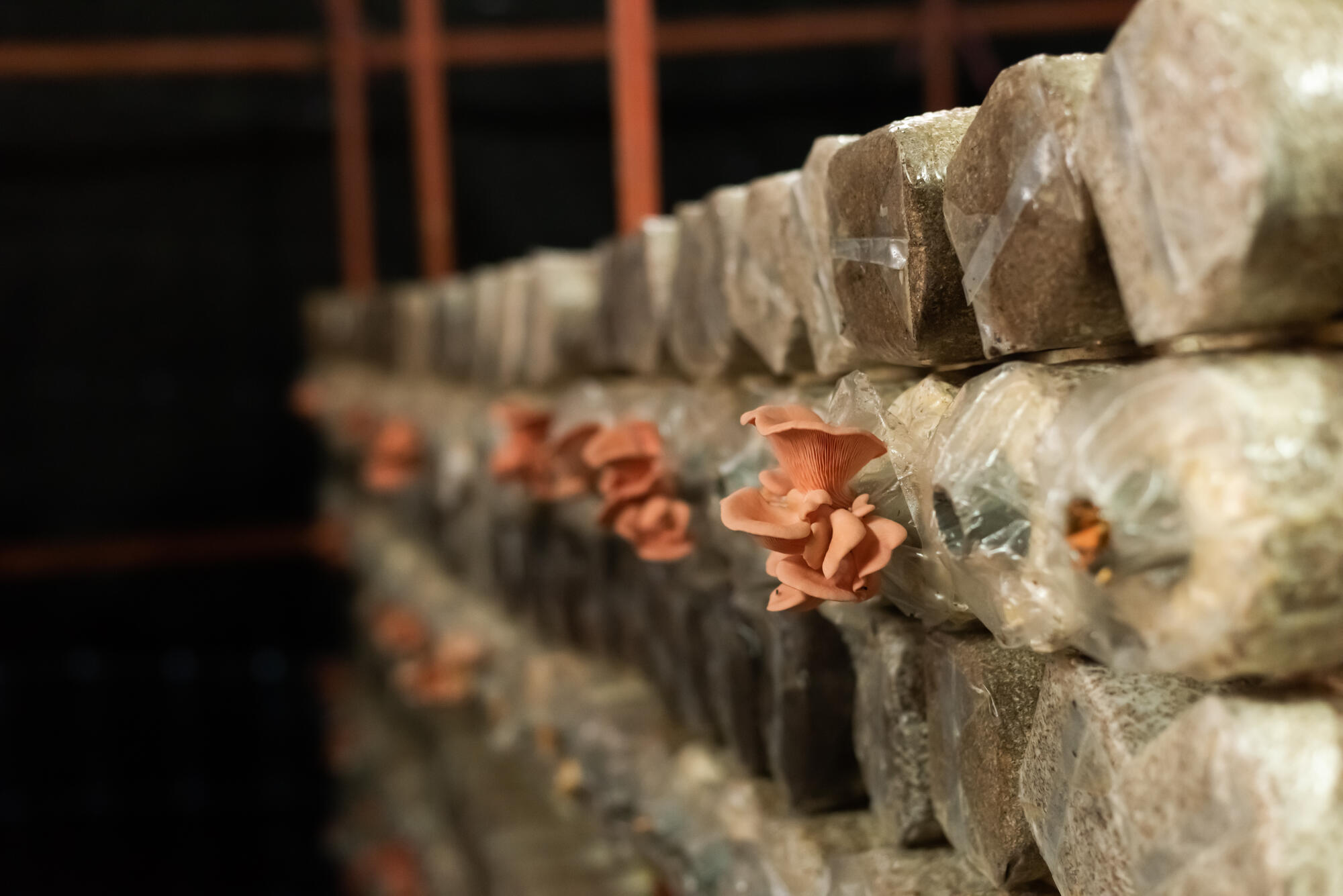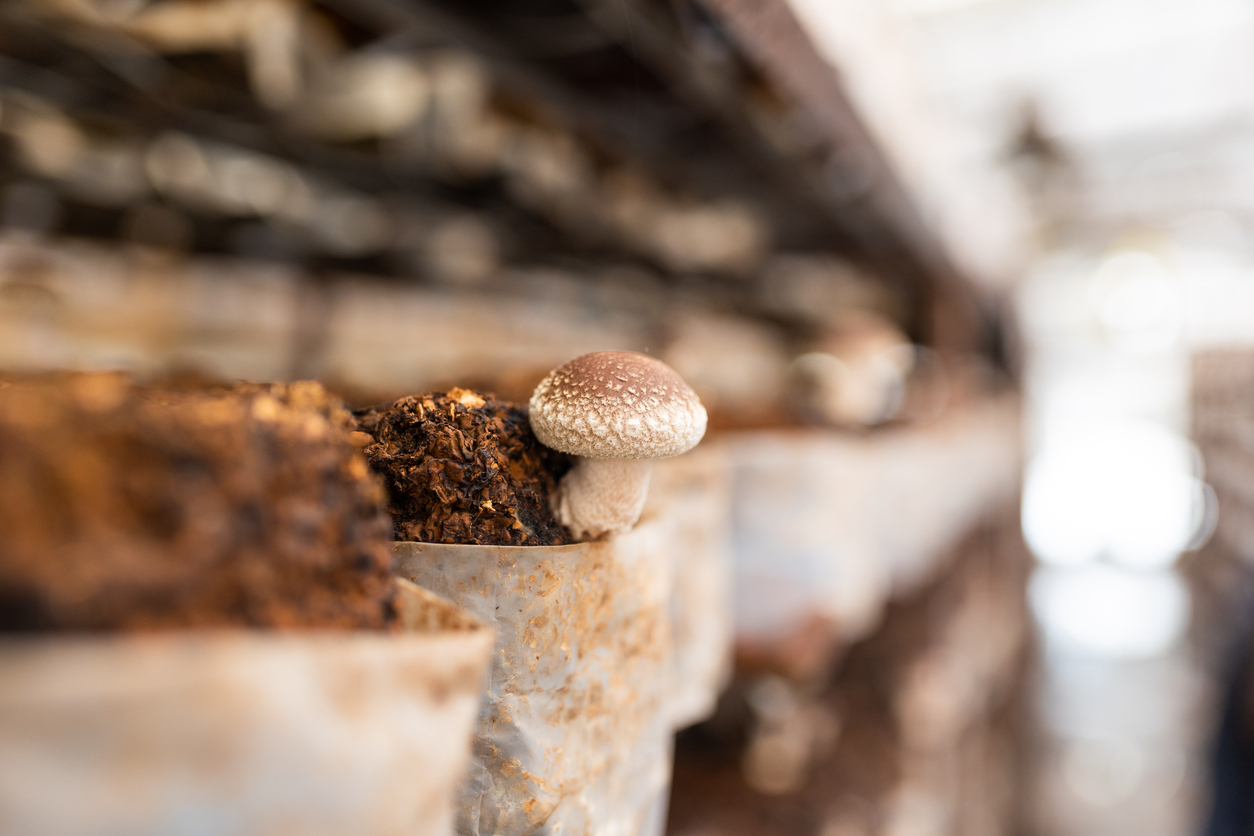
ARTICLE TABLE OF CONTENTS
How to Get Started Growing Gourmet and Medicinal Mushrooms for Profit
A mushroom farm can be a surprisingly successful business venture. This guide unpacks the business of growing gourmet and medicinal mushrooms for profit.
Growing gourmet and medicinal mushrooms offers a golden opportunity for entrepreneurs looking to make a mark. But what are the best steps for getting started?
Today we’re diving into the essentials of launching a profitable mushroom farming venture, from choosing the right mushrooms, to cultivation techniques, to harvesting, and more!

Growing Gourmet and Medicinal Mushrooms: First Steps
Selecting the right type of mushrooms to grow is a key step in starting your mushroom farming business. The choice you make can affect everything from how you set up your farm to how much profit you can make. More people are looking for healthy, sustainable food options, and mushrooms fit this need perfectly.
It’s important to consider a few factors such as market demand, ease of cultivation, start-up costs, and the specific needs of the mushrooms. When it comes to market demand, gourmet mushrooms like Shiitake, Oyster, and Morel are highly sought-after in many upscale restaurants and specialty food stores. They are valued for their distinct flavors and textures.
On the other hand, medicinal mushrooms such as Reishi, Cordyceps, and Lion’s Mane are popular in health and wellness circles for their reported benefits, like boosting immunity and increasing energy levels.
Ease of cultivation is another crucial factor. Some mushrooms are more forgiving and easier to grow, making them ideal for beginners. Oyster mushrooms, for example, are robust and can thrive in a variety of environments.
They’re a good choice for those new to mushroom farming. In contrast, mushrooms like Morel require more specific conditions to grow, which might pose a challenge to new farmers.
Initial Costs and Other Factors
The initial cost of setting up a farm for different types of mushrooms can vary significantly. Some mushrooms might require expensive equipment for creating and maintaining the perfect growing conditions.
Before deciding, it’s useful to calculate the initial investment against the potential market price of the mushrooms to gauge profitability.
The environmental needs of the mushrooms should also be considered. Each type of mushroom has its own requirements for temperature, humidity, and substrate (the material on which mushrooms grow).
For instance, Shiitake mushrooms grow best on hardwood logs or sawdust, while button mushrooms prefer composted manure. Understanding these needs is essential for successful cultivation.
Getting quality spores or spawn (the mushroom equivalent of seeds) is vital. It’s important to source these from reputable suppliers to ensure they are contaminant-free and capable of producing a good yield.
Starting with high-quality spores can save a lot of trouble down the line with issues like disease or poor crop performance.
Lastly, think about your own interests and preferences. Growing mushrooms that you are passionate about can be more rewarding.
If you have a particular interest in the health benefits of mushrooms, you might find more satisfaction in specializing in medicinal varieties. Similarly, if you enjoy cooking, you might be drawn to the rich flavors of gourmet mushrooms.
Setting Up Your Mushroom Farm
Starting a mushroom farm requires careful planning and setup. First, you need to decide whether to grow mushrooms indoors or outdoors, as each environment has its advantages and challenges.
Indoor farming allows for more control over the environment, which can lead to consistent year-round production. Outdoor farming can be less expensive but might be more dependent on the weather and seasonal changes.
The essentials of setting up a mushroom farm include creating the right environment for mushroom growth. This involves controlling temperature, humidity, and light.
Mushrooms generally require a moist, cool, and dark environment to thrive. You’ll need to invest in equipment like humidifiers, temperature control systems, and possibly grow lights if you plan to cultivate mushrooms that require some light.
Substrate Choice and More
The choice of substrate is also critical. The substrate is the material on which mushrooms grow, and different mushrooms require different substrates.
For instance, oyster mushrooms grow well on straw or coffee grounds, while shiitake mushrooms prefer hardwood logs or sawdust. Preparing the substrate usually involves pasteurization or sterilization to kill any harmful bacteria or fungi that could compete with the mushrooms.
Shelving is another important consideration. Most mushroom farms use tiered shelving to maximize space, especially when growing indoors. Efficient use of space is crucial, as it can significantly impact the volume of mushrooms you can produce.
Additionally, the initial setup costs for a mushroom farm can vary widely. These costs are influenced by the scale of your operation and the types of mushrooms you decide to grow.
It’s essential to budget for both the setup and the ongoing costs of substrate, utilities, and labor. Starting small can help reduce initial costs and allow you to learn and adapt without overwhelming financial pressure.
Keeping the farm clean and maintaining a sterile environment are vital to preventing contamination, which is a common issue in mushroom farming. This means regular cleaning and sterilization of equipment and facilities.
Finally, as your farm grows, you might consider automating certain processes. Automation can help manage tasks like humidity control and irrigation more efficiently, which can improve yields and reduce labor costs.

Cultivation Techniques
Mastering the cultivation of mushrooms involves understanding the lifecycle of fungi and managing the growth conditions meticulously. The first step in mushroom cultivation is preparing the substrate, the material on which mushrooms grow.
Depending on the mushroom type, substrates can vary from straw and wood chips to manure and sawdust. Preparing the substrate often involves sterilization or pasteurization to eliminate any unwanted organisms that might compete with the mushrooms.
After preparing the substrate, the next step is inoculation. This is where you introduce mushroom spores or spawn into the substrate.
Ensuring the substrate is at the correct moisture level is critical at this stage, as too much or too little water can hinder mushroom growth. It’s also essential to maintain a clean environment during inoculation to prevent contamination.
Once inoculated, the substrate is placed in a controlled environment where temperature and humidity are carefully monitored. This stage is known as the incubation period.
Incubation and Beyond
During incubation, the mycelium, which is the vegetative part of the fungus, starts to grow throughout the substrate. The environment needs to be kept dark and humid, and the temperature must be suitable for the specific type of mushroom being cultivated.
Following the incubation period, the next phase is the fruiting stage. During this stage, environmental conditions are adjusted to trigger the mushrooms to form fruit bodies, which are the edible parts.
This often involves changing the temperature, introducing fresh air, and adjusting the light. Each type of mushroom has specific triggers that encourage fruiting, and understanding these triggers is key to successful mushroom production.
Harvesting comes after the mushrooms have fully developed. Timing is important because mushrooms can deteriorate quickly if left too long. Mushrooms are typically harvested by hand, and care must be taken not to damage the mycelium, which can produce additional fruit bodies in future cycles.
Throughout the cultivation process, maintaining the right conditions is essential for a good yield. This involves regular monitoring and adjustments to the environment. Issues like mold and bacterial contamination can arise, so it’s important to spot these problems early and address them quickly.
Troubleshooting common issues is a continuous learning process. It involves understanding what normal growth looks like and being able to identify signs of problems like poor mycelium growth or abnormal mushroom shapes.
Successful mushroom farmers often keep detailed records of each crop, noting down environmental conditions and any issues they encounter. This information can be invaluable for refining cultivation techniques over time.
Harvesting and Processing
Harvesting mushrooms at the right time is key to ensuring the best quality and longevity of the produce. The timing of harvest depends largely on the type of mushroom and the desired size for market.
Generally, mushrooms are ready to harvest when the caps have fully opened and the edges remain slightly curled under. Harvesting is usually done by hand to prevent damage to the mushrooms and the growing medium, which can still produce more crops if maintained properly.
Once harvested, processing mushrooms properly is essential to extend their shelf life and maintain their quality. The first step is cleaning, which should be done gently to remove any substrate particles without damaging the delicate flesh. Mushrooms absorb water easily, so it’s often better to brush them clean rather than wash them under running water.
Processing Needs
For many types of mushrooms, especially those intended for immediate sale or use, minimal processing is required. But for long-term storage, more involved methods like drying or freezing can be beneficial.
Drying mushrooms is a popular method because it significantly extends their shelf life and can enhance their flavor. Properly dried mushrooms can be stored for several months and rehydrated when needed. Freezing is another option, although it can change the texture of some types of mushrooms, making them less desirable for certain dishes.
Packaging is another critical aspect of the post-harvest process. Packaging needs to protect the mushrooms from damage, contamination, and moisture loss. It also plays an important role in marketing the product, providing information about the mushrooms, and appealing to consumers.
Adhering to health and safety standards throughout the harvesting and processing stages is essential. This includes ensuring that all equipment and facilities are clean and well-maintained, and that staff follow proper hygiene practices. Compliance with local food safety regulations not only helps in maintaining product quality but also builds trust with consumers.
Finally, efficient logistics are important to get the mushrooms from farm to market quickly and in good condition. This involves planning the best routes and timing for deliveries, as well as maintaining the quality of the mushrooms during transport.
Marketing and Selling Your Mushrooms
Selling your mushrooms effectively starts with understanding who your customers are and what they value. This insight guides how you market and sell your products.
Many mushroom farmers find success selling directly to consumers at local farmers’ markets or through online platforms. These venues allow you to share the unique qualities of your mushrooms, such as being a source of vegan protein or grown sustainably, directly with interested buyers.
Local restaurants and health food stores are also excellent customers for gourmet and medicinal mushrooms. Chefs and store managers are often looking for high-quality, unique ingredients that can set their dishes and product lines apart.
Building relationships with these businesses can be very beneficial. It involves providing samples, discussing the properties of your mushrooms, and demonstrating how they meet the needs of the restaurant or store’s clientele.
When marketing mushrooms, it’s important to emphasize their benefits and appeal. For gourmet mushrooms, focus on flavor, texture, and culinary versatility.
Medicinal Mushroom Marketing
For medicinal mushrooms, highlight their health benefits, such as boosting immunity or reducing stress. Effective branding, including a well-designed logo and packaging, can also help your mushrooms stand out in a competitive market.
Pricing your mushrooms correctly is essential. It needs to reflect the quality of the product and the costs of production while remaining attractive to your target market. It’s often useful to research what similar products are selling for and consider whether your mushrooms offer additional value that could justify a higher price.
Promotional strategies can also play a big role in how well your mushrooms sell. Consider hosting tasting events or workshops on the benefits of mushrooms. Social media can be a powerful tool to reach a broader audience, share the story of your farm, and connect with customers on a regular basis.
Lastly, consistency in quality and supply is crucial for maintaining good relationships with your buyers. They need to know they can rely on you for their mushroom needs. Keeping a consistent schedule and always delivering what you promise builds trust and can lead to long-term business relationships.
Mushroom Entrepreneurship
Growing gourmet and medicinal mushrooms offers a lucrative and sustainable business opportunity. By understanding market needs, perfecting cultivation techniques, and employing effective marketing strategies, you can establish a thriving farm that contributes positively to health, cuisine, and the environment.
At Kyckstarts, our mission is to empower businesses in the alternative ingredient products industry. We understand the unique challenges and opportunities within this dynamic sector and have honed our expertise over years of dedicated research and experience. Get in touch today to find out how we can help!






